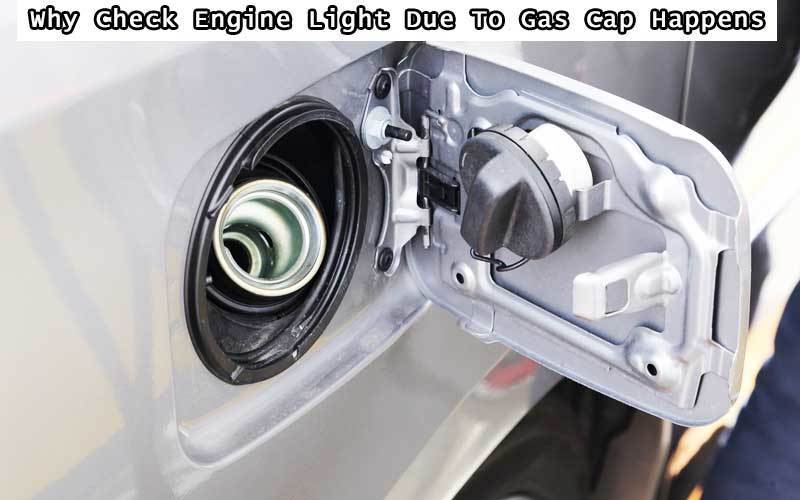So, you’re going for a drive with your car, enjoying the whooshing breeze, adrenaline rush, and life at speed.
Suddenly the worst nightmare for a car owner happens. Your check engine light pops up, out of nowhere, no warning!
Now you think you have to go to a mechanic. The party is broken, the fun is spoiled already.
Not necessarily!!
This incident can happen for many reasons. And yes, you might have to go to a mechanic.
But if the reason lies in check engine light gas cap, you are salvaged. It’s easier to solve than you think.
How? Well, we’re going to discuss that. By the end of this article, you’ll leave being a slightly better mechanic than you were.

How Check Engine Light Detects The Problem?
Most modern cars and trucks now come with OBD II (On-Board Diagnostic System). This automotive diagnostic system monitors several factors including engine and emission related issues, makes sure they’re running properly.
If it finds any issue, like misplaced or damaged gas cap, it will warn the rider. Most of the time the warning sign disappears once the issue is solved. If the sign still remains, the car owner can use an OBD II code scanner and reset the system.
Read to know: 7e8 Engine Code error and solutions
Why Check Engine Light Due To Gas Cap Happens?
The fuel tank contains fuel, which is the material needed for the combustion process. The vehicle will run if the fuel supply is consistent and the fuel is in untainted.
The job of the gas cap is to make sure of that. They prevent water or any trash to go into the fuel tank via the filler neck. Additionally, the gas cap is the part of your vehicle’s evaporative emission system. It makes sure no fuel vapor emits from the fuel chamber and pollute the air.
That being said, there can be several reasons behind check engine light due to the gas cap failure.
If the car has run for a considerably long time, say 50,000 miles with the same gas cap, it’s safe to say that the reason is your gas cap is old, weary and exhausted. It will let pollutants find their way to your fuel chamber, clogging the filter. The engine won’t get uninterrupted fuel supply and the check engine light will flash.
There are other reasons included apart from an old gas cap. This can even happen to new cars. The most common causes of gas cap failures are-
- The cap is not in place or securely sited.
- The cap is completely disappeared or missing from the car.
- The cap cannot close properly due to grime and mud near the opening.
- The gas tank is out of shape due to an accident, putting extra pressure on the gas cap.
A gas cap being out of position is something car owners might frequently encounter. It’s not likely to pose grave threat instantly. But if this problem persists, other symptoms will start to emerge.

Read to solve: 7e9 Engine Code & Solutions
How To Solve The Problem?
The problem is one of the silliest ones you’ll encounter regarding your car. Gas cap, also known as the fuel filler cap, is very easy to locate and fix. It’s the part you close and opens every time you fill the fuel tank. Here are the steps on how to address this issue.
1. Open The Gas Cap Door
Once you’ve noticed the check engine flashing, don’t worry. If it’s for gas cap failure, the fixing will take a mere few minutes.
Turn off the engine vehicle. Open the gas cap door. The door is usually locked, you’ll find a push button to unlock it. The button should be located under the steering column or the floorboard beside the driver’s side seat.
2. Check The Gas Cap
Open the gas cap door. If it is dark, take a flashlight with you. You need to be able to see any damage or crack on the gas cap, so you’ll need additional lighting. Grab the gas-cap handle. Twist it anti-clockwise to open it.
Now, if the gas cap is missing altogether, all you need to do is install a new one (coming to that in a bit). But if the cap is there, check closely for crack, tear or chips.
If you find any damage, the cap needs to be replaced. If not, check the seal in between the filler tube and the gas cap. Look for any damage or crack that might cause vapor leak.
3. Install/Replace The Gas Cap Properly
Now, if you find any damage on your gas cap, it’s time to throw it and install a new one. It isn’t a costly purchase. Make sure the new one is the right fit for your vehicle brand and model.
If the gas cap seems okay, make sure you reinstall it properly. Either way, the installing system follows below-
- Fully install the cap into the filler tube.
- Make sure the threads sit and seal properly.
- Turn the gas cap clockwise to tighten it.
- Continue to do so until you hear the cap clicking three times.
These steps should solve the problem. Start driving and the check engine light will disappear over time.

How To Prevent Gas Cap Problems?
Regardless of what you do, gas cap might need replacing once in a while. However, you can avoid most of the problems by staying careful. Follow our tips-
- Always make sure you tighten the cap securely after fueling.
- Listen to your gas cap and tighten until the click sound.
- Keep the car clean, especially the fuel tank area.
- Make sure the gas pump is in place while fueling
- Always close the lid that covers the gas tank and the gas cap.
Final Words
You’ve checked your gas cap, addressed the issue. You’re done and good to go. Start driving the car and give the OBD II system one day to reset. In case the light is still showing, use an OBD II scanner to reset it.
That’s assuming the problem lies in the gas cap. However, if your gas cap doesn’t show any visible damage, perhaps the check engine light is showing due to other reasons.
Whatever the issue, the key is not being stressed and see if you can fix this. If you can’t, go to a professional computer diagnostics.


Bought a locking gas cap and toped off my fuel locked the gas cap–no engine light–parked my car–for a week—restarted my car and engine light came back on–went back to check gas cap and found it loose?? A locked gas cap and checked it a week later–loose? Is someone messing with my car??